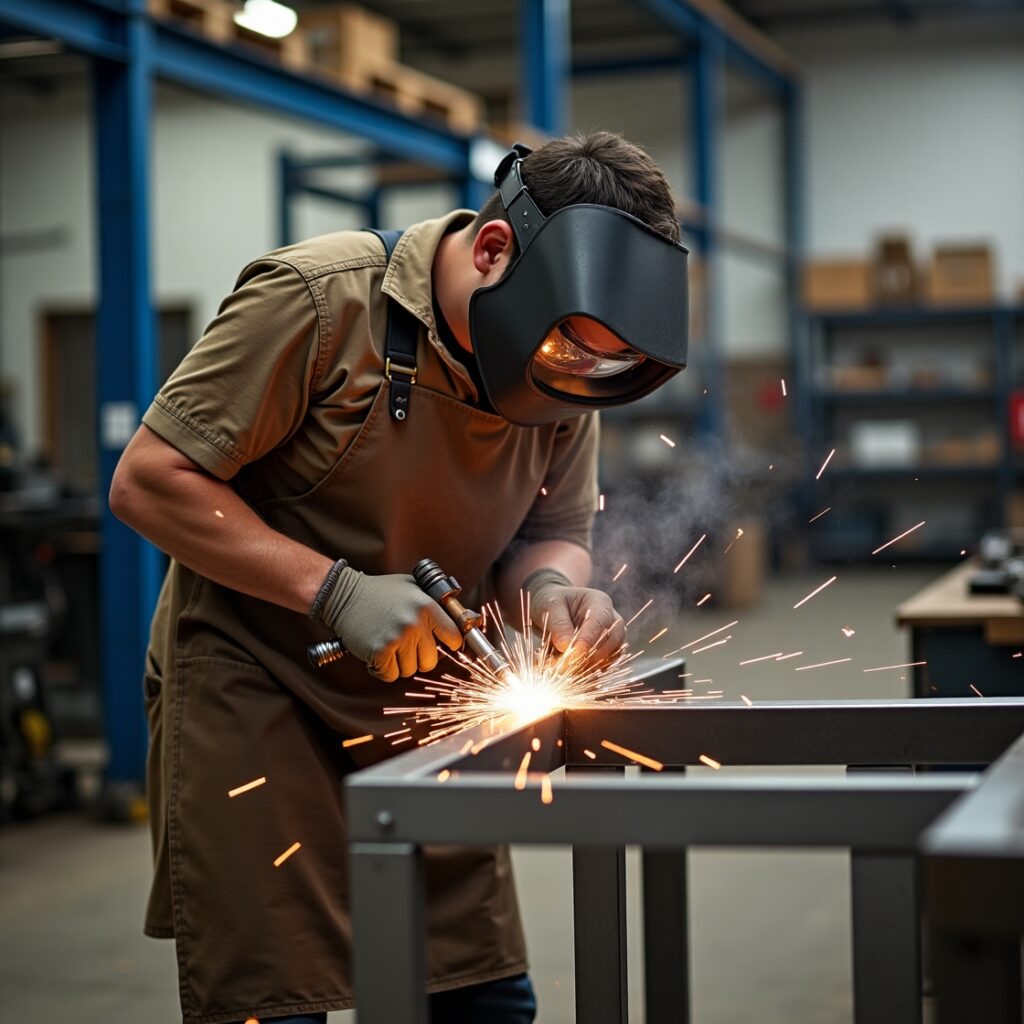Collaboration in metal fabrication stainless steel projects. When fabricators and contractors work together, the result is a smoother process and better-quality outcomes.
In the construction and manufacturing industries, collaboration is key to project success. One of the most crucial partnerships is the relationship between fabricators and contractors, especially in the field of stainless-steel metal fabrication. While both professionals play distinct roles, their ability to work together seamlessly often determines the efficiency, quality, and timely delivery of the final product. The strength of this collaboration not only ensures structural integrity but also helps meet strict safety regulations and design specifications. When executed correctly, it lays the foundation for visually impressive, long-lasting, and cost-effective structures—ranging from commercial facades to bespoke interior features.
In this article, we explore how fabricators and contractors can collaborate more effectively, what each party brings to the table, and why stainless steel remains one of the most sought-after materials in modern construction and design. We’ll also provide practical examples and best practices to foster better working relationships, ensuring smoother project lifecycles and more successful outcomes for all stakeholders involved.
Understanding the Roles

What Fabricators Do
Fabricators are highly skilled professionals who take raw metal materials and transform them into usable components through precise techniques such as cutting, bending, forming, welding, polishing, and assembling. In the context of metal fabrication stainless steel, they produce bespoke or standardised items like frames, balustrades, staircases, railings, cladding, support beams, canopies, signage, and architectural features. Each item must meet strict tolerances to ensure it integrates correctly with the overall structure.
Fabricators are the bridge between raw material suppliers and the finished product seen in buildings, machinery, or infrastructure. They interpret technical drawings, use CNC and laser cutting tools, and often work under pressure to deliver components that are both structurally sound and aesthetically pleasing. Their craft plays a vital role in enhancing a building’s durability and functionality, especially when stainless steel is involved—a material celebrated for its corrosion resistance, hygiene properties, and sleek, modern appearance.
The Role of Contractors
Contractors, on the other hand, take on a broader project management role. They are responsible for planning, coordinating, and executing the overall construction or installation process, ensuring all phases—from groundwork to handover—are completed on time, within budget, and to client specifications. In projects involving metal fabrication stainless steel, contractors liaise with various subcontractors, including fabricators, to integrate custom metal elements into larger architectural or structural designs.

A contractor’s responsibilities also include risk assessment, compliance with local building regulations, ensuring health and safety protocols are followed on-site, and managing resources and labour. Their ability to effectively communicate with suppliers like fabricators significantly impacts project efficiency, quality, and the avoidance of delays or costly mistakes.
Why Collaboration Matters
1. Seamless Integration of Fabricated Components
Stainless steel components often serve both structural and decorative purposes. For example, a fabricated stainless steel staircase must not only look sleek and modern but also meet strict load-bearing requirements and building codes. Without close collaboration, there’s a risk of dimensional inaccuracies or design mismatches that can delay the project or compromise safety.

Collaboration in metal fabrication stainless steel projects work becomes clear when contractors and fabricators engage in regular dialogue during the design and planning stages. This ensures all components are manufactured with a clear understanding of how they’ll be installed and used. Fabricators benefit from early access to architectural drawings, 3D models, or BIM data, which helps them deliver parts that slot into the final build without on-site modifications. The result is better alignment between vision and execution—something that is especially important in premium commercial or hospitality projects, where attention to detail is paramount.
2. Time and Cost Efficiency
Project delays are one of the most common challenges in the construction industry, and poor communication between contractors and fabricators is often a root cause. Delays not only inflate costs but can also damage reputations and lead to disputes. A collaborative approach ensures that both parties are aligned on lead times, delivery dates, installation sequencing, and change orders.

For instance, if a contractor identifies a structural change mid-project, informing the fabricator promptly allows them to adjust their production plans before materials are cut or welded. This avoids wasted effort and reduces the risk of having to discard valuable stainless steel components. Furthermore, streamlined communication allows for better inventory planning, reduced site storage needs, and fewer last-minute surprises—creating a smoother workflow for everyone involved.
3. Improved Quality and Safety
Quality assurance and site safety are non-negotiable in construction. When fabricators and contractors collaborate closely, the result is a safer, more controlled environment. Fabricators can advise on handling, transportation, and installation methods for stainless steel parts, which are often heavy, sharp-edged, or sensitive to surface damage. They can also flag any potential installation hazards ahead of time, allowing contractors to prepare the site accordingly.

Moreover, collaboration allows for robust quality control processes to be established early. Fabricators can offer material certifications, test welds, or surface finishes to meet industry standards, while contractors ensure that installations adhere to engineering drawings and structural tolerances. This level of cooperation fosters accountability and consistency, reducing the risk of rework or failure post-installation.
Best Practices for Effective Collaboration
Early Involvement of Fabricators
One of the best ways to improve collaboration is by involving fabricators early in the project lifecycle—ideally during the conceptual design phase. Their knowledge of material properties, fabrication limitations, and optimal construction methods can greatly influence design decisions. They may suggest switching to a more suitable grade of stainless steel or altering joint designs to simplify fabrication and reduce costs.
When fabricators are brought in late, key design elements may need to be changed to accommodate practical constraints, leading to frustration and avoidable delays. Involving them from the beginning ensures that the project is built on a foundation of technical feasibility, aligning aesthetics with real-world manufacturing capability.
Clear Communication Channels
Consistent, transparent, and accessible communication is essential for any partnership to thrive. Collaboration in metal fabrication stainless steel projects, contractors and fabricators should agree on communication protocols from day one. This may include shared digital platforms for documentation, weekly progress calls, or joint site visits. Every revision to a drawing or design spec should be documented, time-stamped, and acknowledged by both parties.
In today’s digital age, using cloud-based project management tools or BIM (Building Information Modelling) software can greatly enhance collaborative visibility. Everyone can access real-time updates, avoiding the risk of acting on outdated or incomplete information.
Flexibility and Problem-Solving
Even the best-planned projects can face unexpected challenges—material shortages, design revisions, weather delays, or site access issues. In such cases, a strong relationship between fabricator and contractor encourages constructive problem-solving, not blame-shifting.
A flexible and solutions-oriented mindset helps both parties find alternative materials, redesign a component, or reschedule installations without derailing the entire project. When mutual respect exists, everyone is more likely to pull together and keep the end goal in focus.

The Role of Stainless Steel in Modern Projects
As a material, stainless steel continues to dominate the architectural, structural, and industrial sectors thanks to its resistance to corrosion, heat, and staining. It is not only aesthetically pleasing—with its smooth, reflective finish—but also incredibly strong and recyclable. This makes it ideal for projects that demand both performance and sustainability.
Whether it’s used for kitchen counters, stair balustrades, structural frames, or decorative cladding, stainless steel delivers long-term value. Its strength-to-weight ratio is impressive, reducing structural load without compromising durability. In environments exposed to moisture, chemicals, or heavy usage—such as hospitals, kitchens, transport hubs, or retail spaces—stainless steel is the clear choice for longevity and hygiene.
The effectiveness of metal fabrication stainless steel lies in precision: every weld, polish, and bend must meet exact tolerances. This precision can only be achieved through open communication and technical collaboration between fabricator and contractor, ensuring each element fits perfectly into the broader structure.
Real-World Example: A Stainless Steel Balustrade Installation

Let’s take a real-world example of a commercial refurbishment project in Birmingham involving the installation of custom stainless steel balustrades. The contractor had a tight timeline and high-end aesthetic requirements for a multi-storey office building. Early in the project, they engaged a local metal fabricator with experience in architectural stainless steel components.
Through a series of design workshops and material consultations, the fabricator advised on the best grade of stainless steel for indoor use (Grade 304), suggested a brushed satin finish to match interior decor, and proposed welded joints for a seamless look. They also flagged potential load-bearing issues that required minor adjustments to the stairwell design.
Because the fabricator was involved early, the components were delivered on time and installed with minimal disruption. The end result? A sleek, durable balustrade that elevated the look and value of the building—delivered without delays, cost overruns, or quality issues.
Building Stronger Partnerships for Better Outcomes
In today’s fast-paced the collaboration in metal fabrication stainless steel projects, between contractors and fabricators is not just helpful—it’s essential. Strong partnerships built on mutual respect, technical understanding, and clear communication lead to better outcomes for everyone. When fabricators are seen not just as suppliers but as strategic partners, projects benefit from enhanced quality, reduced costs, and faster turnaround times.
As stainless steel continues to play a pivotal role in architecture and construction, the importance of metal fabrication stainless steel expertise cannot be overstated. From the initial design phase to final installation, every step requires attention to detail, problem-solving, and teamwork.
So whether you’re a contractor managing a large commercial development or a fabricator supplying bespoke stainless steel parts, prioritising collaboration could be the key to your next project’s success.
Need a trusted partner in stainless steel fabrication?
Contact our expert team today. We work hand-in-hand with contractors to deliver precision-made stainless steel components—on time, on budget, and always to spec.

